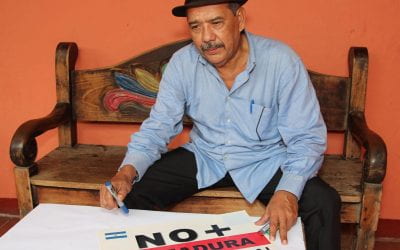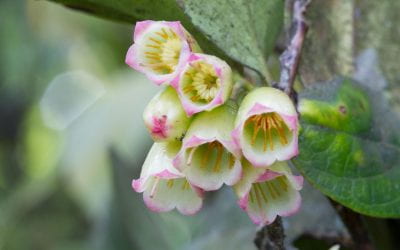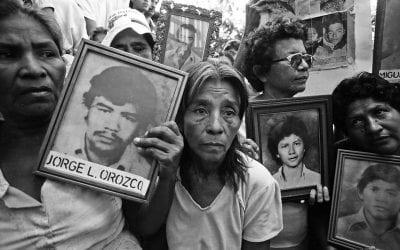Nicaragua: The Roots of the Current Crisis
Photos by Lorne Matalon
When I was a political science student at the Autonomous University of Barcelona in the late 80s, I encountered the Sandinista solidarity movement. On finishing my studies, those connections led me to spend some time in Nicaragua. Two professors in Barcelona put me in contact with the then-dean of the Law School at the Autonomous University of Nicaragua in León (UNAN-León), and she suggested I teach some seminars in exchange for room and board. I liked the idea a lot. I wanted to experience first-hand the revolution that had so surprised the world and gained its affections.
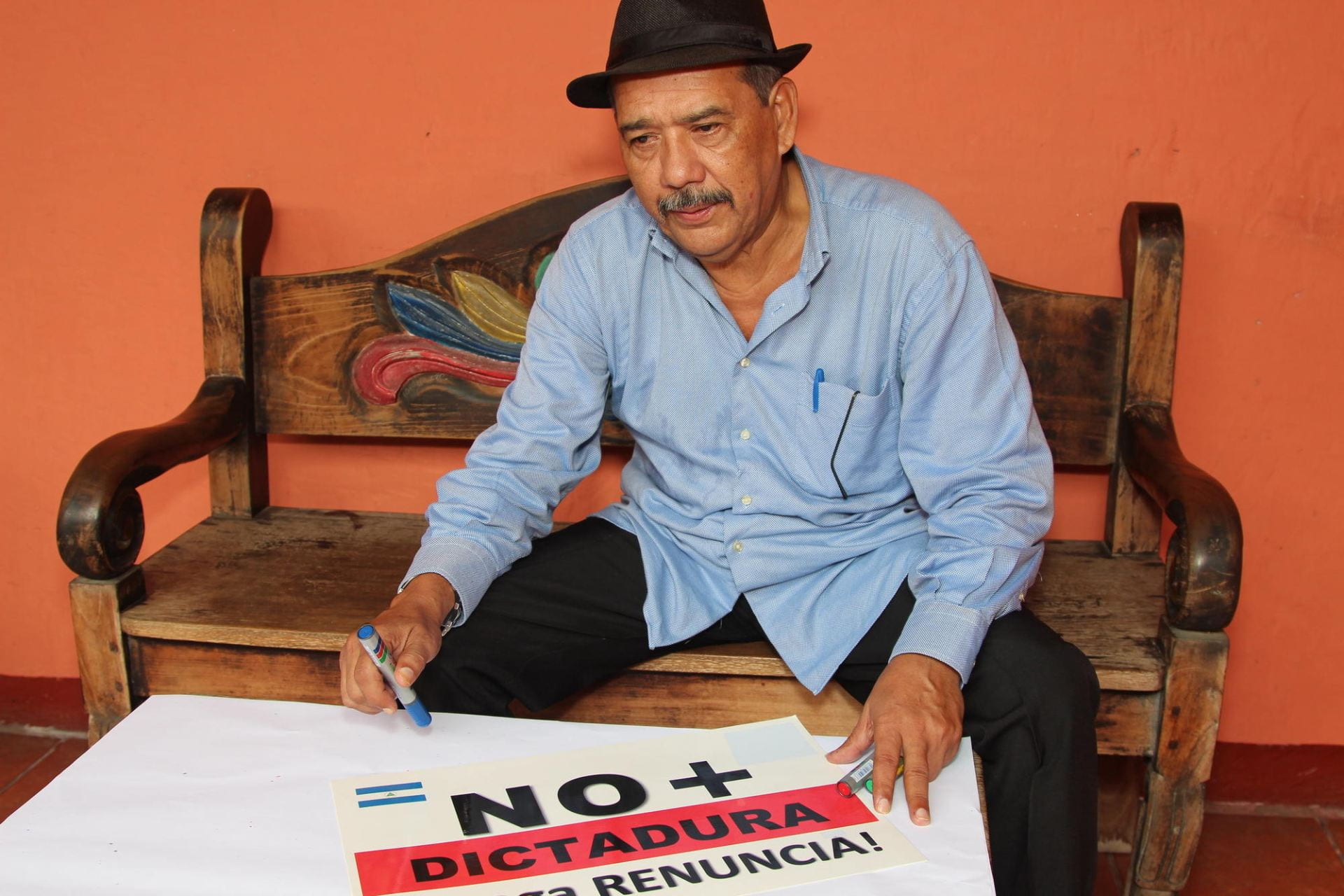
Ex-guerrilla Carlos Humberto Silva Grijalva is proud to have been a part of the 1979 Sandinista revolution that toppled US-backed dictator Anastasio Somoza. The sign he made prior to a demonstration reads, ‘No more dictatorship, Ortega resign.’ Silva’s son, Carlos Humberto Silva Rodríguez, has been jailed on what one human rights worker said are fabricated charges of vandalism.
But what actually happened, however, is that I arrived in a Nicaragua where the revolution no longer existed. The Sandinistas had lost the February 25, 1990, elections. I ended up in a country that was halfway to reconciliation, demobilization and economic ruin. Exiles from Miami had returned home, eager for revenge, and the Sandinistas had a lot to deal with. Some of these Sandinistas tried to look for answers about why the revolution had fallen out of favor and regard among Nicaragua’s populace. Another group passed the days endlessly accusing other Sandinista factions of committing errors over the course of a decade. In the middle of all these squabbles, a certain number of Sandinistas—a minority, but very visible—took advantage of the chaos to make themselves rich. I think it was the worst moment—and the worst country—for a student to embark on his virgin, epic and romantic journey. I don’t mean to suggest that this first experience was not interesting, because it left me with profound lessons about human nature and developing societies.
Is it possible that this experience influenced the way in which, ever since that time, I have evaluated Latin American politics in general and Nicaraguan politics in particular? Perhaps because of this experience, I have been more concerned with identifying historic “continuities,” rather than abrupt “changes.”
This inclination to analyze the continuities in Nicaraguan politics, rather than its ruptures, is relevant, especially because in a little more than a century, Nicaragua has experienced North American occupation, a liberal oligarchical regime, a repressive family dictatorship, a revolutionary regime with socialist inclinations, a liberal democracy and since 2007 (with the return of Daniel Ortega to power) a hybrid regime that has combined democratic institutions with authoritarian elections, and, since 2018, has transformed into yet another tyranny.
Nicaragua’s current crisis surprises many people who only think of Nicarauga in terms of the 1979 insurrectional victory and the 1990 electoral defeat of the Sandinista Revolution. Precisely, and in spite of their differences, the two episodes in 1979 and 1990 were exceptions to the rule. The revolution was unique because of its multiple leadership (of nine comandantes) that condemned and did away with strongman rule and the cult of personality. Moreover, the FSLN abandoned Leninist dogma and put pluralism into practice, offering the possibility of ceding the government to whoever won in fair and competitive elections, as happened in 1990 with the victory of Violeta Barrios de Chamorro.

Silva Grijalva’s wounds on his right leg were inflicted by rubber bullets that he and others who were with him alleged were fired by pro-gov’t paramilitaries.
But this exceptionality soon disappeared and the patrimonial and despotic logic of politics once again began to flourish. On one hand, the FSLN failed in its attempt to democratize itself and rapidly became fiercely controlled by por Daniel Ortega. The liberal democracy inaugurated in 1997 diminished with the arrival of a corrupt president, Arnoldo Alemán, who made a pact with Ortega in 2000 to take control of the country’s institutions. Nicaraguan politics reverted to old patterns. The political culture based on concentration of power and cooptation (or expulsion) of the opposition resulted in the dismantling of balance of powers and the rise of impunity.
Since 2007, with Daniel Ortega’s return to power, the elements of continuity with the Somoza regime reappeared with the vastly increased concentration of public and private resources in the hands of relatives and close allies. This continuity also manifested itself in the tight reins on the administration of the state, including the Army and the Police, allegedly independent agencies, the electoral machinery and the judicial system. The only thing which distinguished Ortega from Somoza was that the former only used violence on rare occasions. That difference disappeared April 18, 2018, when prote4sts broke out against Ortega, setting off fierce repression from the government. According to statistics provided by the Nicaraguan Human Rights Association (ANPDH) in April 2019, the toll is already 561 dead, 4, 578 injured, and more than 1,300 personas imprisoned, and some 60,000 in exile (exact numbers vary among human rights observers).
Not only did Ortega usurp the FSLN and its symbols as his own patrimony, he concentrated the power of the State in his figure (and that of his wife) and rejected any criticism; he has undemocratized the country, This means that the regime has had the capacity to expel the opposition from institutions, to take legal status away from inconvenient political parties and to create puppet electoral formations to weave political complicities to present an appearance of plurality. In this sense, the crisis of governing that the country is experiencing today cannot be resolved by resurrecting old political parties or by the ad hoc creation of new political formations. A worthy way out from the crisis means far-ranging political and institutional changes, because one thing is the fact that the regime is widely rejected and another is to be able to compete in elections against the FSLN with guarantees.
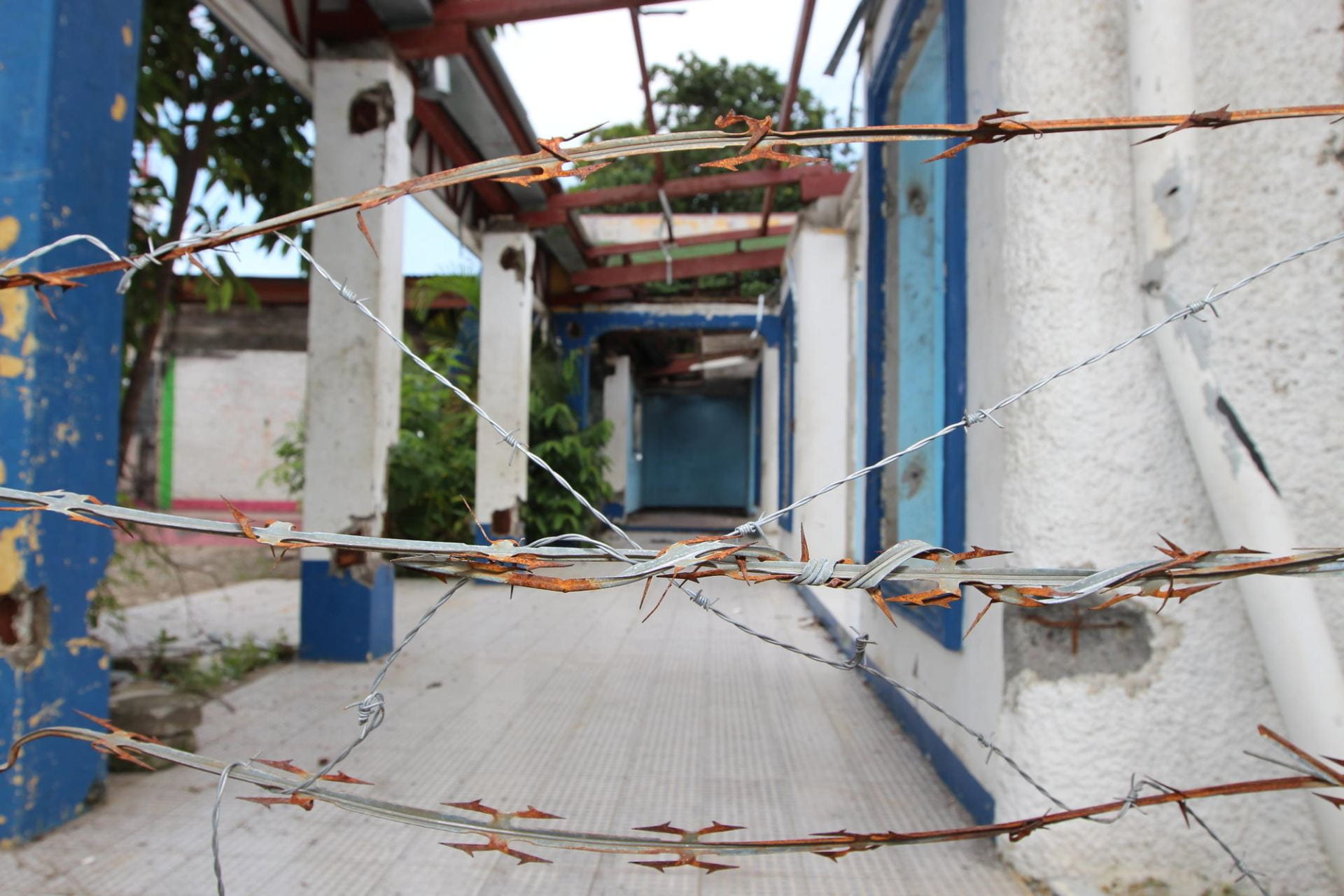
In Masaya, gov’t opponents vandalized the public prosecutor’s office after state security forces attacked the neighborhood.
The regeneration of an active Nicaraguan political life isn’t just about organizing new elections; a long road lies ahead. The process of undemocratization that has been carried out over the last decade has not only broken down the electoral administration but has also greatly weakened all political party and associative activities. Thus, any solution to the current situation takes place outside the framework of fossilized institutions and parties.
Negotiation outside institutional frameworks has also been a constant in Nicaragua’s history. Changes of substance in Nicaraguan politics have almost always been the result of negotiations outside of the context of institutions (seeing that these institutions have generally been corrupted by the regime in power). Two opposing sides face off after a “damned stalemate.” The most recent examples of this type of negotiation are the agreements reached at the end of the 80’s (in the framework of the Esquipulas Peace Agreement) between the Sandinista government and the Contra; the negotiations established in 1990 between President-elect Violeta Barrios de Chamorro and the FSLN in 1990 to draw up the Protocol of Transition of the Executive Power and more recently “The Governability Agreement” in 2000 (more commonly known as “the Pact”) between Alemán and Ortega, which set of the erosion of Nicaragua’s incipient democratic system.
Because of this history, many believed that May 16, 2018, a dialogue was going to begin that would be similar to the first session of the National Dialogue, in which members of the government, university sectors, unions, civil society and employer stakeholders came together with the mediation of the Nicaraguan Bishops Conference. That dialogue failed because the government did not put an end to the repression and showed absolutely no interest in furthering a democratizing agenda. Ortega put the blame for the dialogue’s failure on the Catholic Church, a criticism that was not casual because the church represented the only institution present throughout the entire country that was grounded in voice and authority. Ten months later, a “new” dialogue was proposed, but with fewer players and with very limited expectations. The interlocutors were, on one hand, the government, and on the other, the Civic Alliance for Justice and Democracy, with the Vatican as mediator. The difficulty of this new dialogue was, however, the existence of political prisoners and exiles, as well as the continued repression of the opposition. This second dialogue was indefinitely suspended on April 23, 2019, and nobody knows if there will be a third dialogue.
Today the question is how to get out of the crisis in a peaceful way that will be accepted by the different players in the framework of a very unequal and changing correlation of forces. In possible (and futuristic) negotiations, there are several “red lines” that cannot be crossed for each of the players, and at times they are not compatible. For Ortega, these could be economic, political and legal guarantees for himself and his clan, that is, that his family fortune would not be expropriated, that he could conserve a share of power in the institutions of a hypothetical “new regime” and that he would not be tried in the International Criminal Court for crimes against humanity. On the other side, the most combative of the social movements, the Articulation of Social Movements and the Organizations of Civil Society, have indicated that it is absolutely necessary to promote policies of justice, truth and reparation for the victims and to ask for Ortega’s immediate departure. The Civil Alliance for Justice and Democracy adopts a position between these two stances, calling for institutional reform that sets up an electoral calendar with a new electoral law and the presence of international observers; an agenda of human rights that includes the liberation of political prisoners and the annulment of trials of those arrested for protesting against the regime, disarmament of paramilitary groups, end to the repression, freedom of the press and the free return of exiles with international human rights organizations as garantors of these steps, and an agenda of economic development to combat the recession.
Nevertheless, to return to the negotiations table is difficult because the opposition is not structured; social movement leaders don’t dare show up; there are no effective opposition parties, nor is there freedom of assembly or press with which to debate. , In this sense, the representation is imperfect and those who sit at the negotiating table—the Civic Alliance—do not have their own force, but depend on international actors and the capacity to get people out onto the streets. The great unknown at this time is the position of the Army, which although it has been closely allied with Ortega, has its own economic and institutional interests to defend, as well as its very prestige beyond the permanence of the current president and power.
At any rate, at the time of writing this text in mid-June, 2019, there are no signs peace will be achieved in the foreseeable future, although there are some signs of easing of tensions such as the liberation of 56 prisoners June 11. Ortega’s discourse is focused on calling out his adversaries, of denouncing that he has been the victim of a “soft coup” and of urging his loyalists to resist. In this sense the motto from the seat of power is clear and forceful: “Daniel is staying.”
Thus, the actual crisis has demonstrated continuities in the exercise of the political culture of power in Nicaragua, the concentration of resources in the hands of a strongman. the use of force at critical moments and the incapacity of the institutions to resolve conflicts. The fruits of these continuities are political violence and impunity, reappearning once again in Nicaragua. Nevertheless, It is difficult to think that this crisis could last forever. It is hard to imagine Ortega in power forever through the use of forcé. In this sense the French priest, politician and diplomat Charles Maurice de Tayllerdand warned us a couple of centuries ago, “You can do everything with bayonets except sit on them.”
Nicaragua: algo más que una crisis coyuntural
Por Salvador Martí i Puig
Fotos por Lorne Matalon
Cuándo era estudiante de Ciencia Política en la Universidad Autónoma de Barcelona, a finales de los años 80, entré en contacto con el movimiento de solidaridad con la Revolución Sandinista y por ello, al finalizar la licenciatura pensé en la posibilidad de hacer una estancia en Nicaragua. Dos profesores de Barcelona me pusieron en contacto con la entonces decana de la Facultad de Derecho de la Universidad Nacional Autónoma de Nicaragua en León (UNAN-León) quien me propuso impartir unos seminarios a cambio de alojamiento y comida. Me pareció una excelente idea. Quería vivir en directo una experiencia revolucionaria que asombró y enamoró a medio mundo.
La cuestión, sin embargo, es que al llegar a Nicaragua ya no había revolución: los sandinistas habían perdido las elecciones celebradas el 25 de febrero de 1990. Así pues, llegué a un país a medio camino entre la reconciliación, la reconstrucción, la desmovilización y la ruina. El exilio de Miami había vuelto al país con ansias de revancha y los sandinistas estaban muy atareados. Una parte de ellos se preguntaba por qué la revolución había perdido el favor y la estima del pueblo; y otra parte se peleaba acusándose mutuamente de todos los errores cometidos a lo largo de una década. En medio de estas peleas unos cuantos dirigentes sandinistas—que eran una minoría, pero muy visible—aprovechaban el desconcierto para enriquecerse. Creo que era el peor momento—y el peor país—para que un estudiante hiciese un viaje iniciático, épico y romántico. Con esta introducción no quiero señalar que mi primera experiencia en Nicaragua no fuera interesante, pues de ella extraje un aprendizaje profundo de la naturaleza humana y de las sociedades en desarrollo.
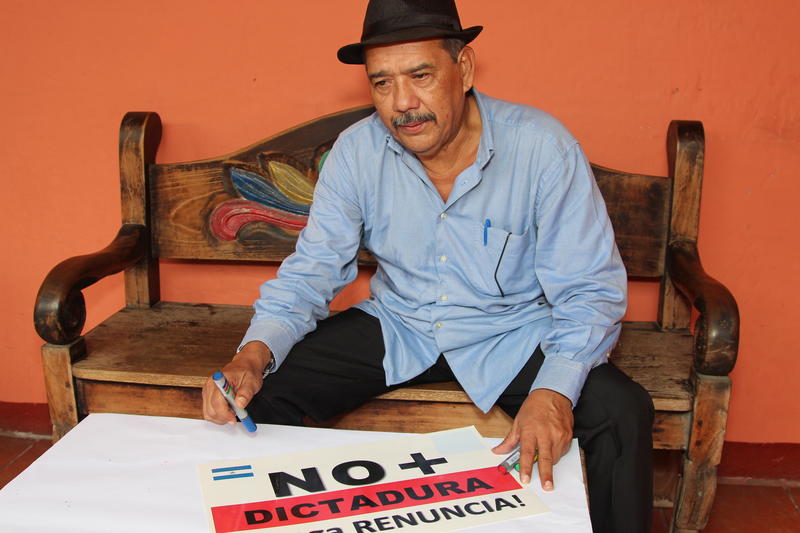
Ex-guerrillero Carlos Humberto Silva Grijalva está orgulloso de haber formado parte de la Revolución Sandinista 1979. El aviso que hizo antes de una demostración dice, “No mas dictadura, Ortega renuncia.” El hijo de Silva, Carlos Humberto Silva Rodríguez, ha sido encarcelado por lo que un trabajador de derechos humanos llama cargos falsos de vandalismo.
Es posible que esta experiencia influyera la forma en que, desde entonces, he analizado la política en América Latina en general y la de Nicaragua en particular. Quizás por ello me ha preocupado más identificar las “continuidades” históricas que los “cambios” abruptos.
Esta inquietud—la de analizar las continuidades de la política nicaragüense más allá de las rupturas—es relevante, ya que en poco más de un siglo Nicaragua ha experimentado la ocupación norteamericana, un régimen liberal oligárquico, una represiva dictadura familiar, un régimen revolucionario de corte socialista, una democracia liberal y, desde 2007 (con la vuelta de Daniel Ortega al poder) un régimen híbrido que ha combinado instituciones democráticas con elecciones autoritarias y que, a partir de abril de 2018, se ha convertido en una otra tiranía.
La crisis en que está inmersa actualmente Nicaragua sorprende a muchas personas cuya única referencia del país fue la victoria insurreccional (en 1979) y la derrota electoral (en 1990) de la Revolución Sandinista. Precisamente, y a pesar de sus diferencias, los dos episodios acontecidos en 1979 y 1990 fueron excepcionales. La Revolución fue única por su liderazgo múltiple (de nueve comandantes) que condenaba y descartaba el caudillismo y el culto a la personalidad. Además, el FSLN abandonó el dogma leninista y puso en práctica el pluralismo, ofreciendo incluso la posibilidad de que accediera al gobierno la formación que ganara en unas elecciones libres y competitivas, tal como sucedió en 1990 con la victoria de Violeta Barrios de Chamorro.
Pero al poco tiempo esta excepcionalidad se desvaneció y reapareció la lógica patrimonial y despótica en la vida política. Por un lado, el FSLN fracasó en el intento de democratizarse y rápidamente fue férreamente controlado por Daniel Ortega. También la democracia liberal que se inauguró en 1990 mutó en 1997 con la llegada al poder de un presidente corrupto, Arnoldo Alemán, que no tuvo reparos en pactar en el año 2000 con Ortega para apropiarse de las instituciones del país. Entonces la política nicaragüense volvió a encauzarse a través de los patrones tradicionales y reapareció una cultura política basada en la concentración del poder, en la cooptación (o expulsión) de la oposición, en el desmantelamiento de contrapesos institucionales y en la impunidad.
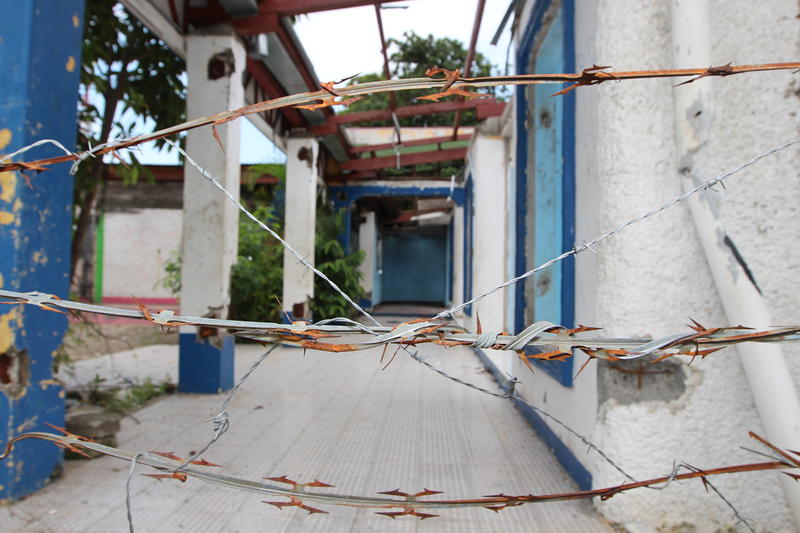
Las heridas de Silva Grijalva en su pierna derecha fueron producto de balas de goma disparadas por paramilitares a favor del gobierno, según Grijalva y otros que lo acompañaban.
Desde 2007, con la vuelta al poder de Daniel Ortega, reaparecieron aún con más fuerza elementos de continuidad con el somocismo al concentrar una gran cantidad de recursos públicos y privados entre sus familiares y allegados, y al controlar todos los resortes de la administración del Estado, incluyendo el Ejército y la Policía, las agencias supuestamente independientes, la maquinaria electoral y el poder judicial. La única cosa que parecía distinguir a Ortega de Somoza era que el primero sólo utilizaba excepcionalmente la violencia. Como es sabido esta diferencia desapareció a partir del 18 de abril de 2018, cuando estallaron protestas en su contra y se desató desde el gobierno una feroz represión. El balance de ésta, según datos ofrecidos por la Asociación Nicaragüense Pro Derechos Humanos en abril de 2019 (ANPDH), ya es de 561 muertos, 4.578 heridos, más de 1.300 personas sin libertad y unos 60.000 exiliados.
Pero Ortega no sólo ha patrimonializado el FSLN y sus símbolos, ha concentrado el poder del Estado en su figura (y el de su esposa), y ha rechazado cualquier crítica; sino que también ha des-democratizado el país. Esto significa que el régimen ha tenido la capacidad de expulsar a la oposición de las instituciones, despojar a los partidos incómodos de personería jurídica y crear formaciones electorales títeres para tejer complicidades políticas con apariencia de pluralidad. En este sentido la crisis de gobernanza que hoy vive el país no se puede solucionar sólo resucitando los viejos partidos tradicionales, ni creando ad hoc nuevas formaciones políticas. Una “salida” digna de la crisis significa cambios políticos e institucionales de gran alcance, pues una cosa es el rechazo popular al régimen y otra muy diferente poder competir electoralmente contra el FSLN con garantías.
Pero la regeneración de la vida política nicaragüense no pasa sólo por organizar unas nuevas elecciones. Para que se reactive la vida partidaria y las formaciones compitan en comicios democráticos es preciso un largo camino. El proceso de des-democratización llevado a cabo a lo largo de la última década no sólo ha desbaratado la administración electoral, si no que ha descompuesto toda la vida asociativa y partidaria. Precisamente por ello cualquier solución pasa por una negociación fuera del marco de unas instituciones y formaciones esclerotizadas.
Esta vía—la negociación fuera del marco institucional—también ha sido un elemento permanente en la historia del país. Es más, casi siempre los cambios sustantivos que se han dado en la política nicaragüense han sido el resultado de negociaciones fuera de las instituciones (previamente vaciadas de representatividad por el régimen en curso) entre actores enfrentados que se reconocen como interlocutores fruto de un “empate maldito”. Los ejemplos más recientes de este tipo de negociaciones son los pactos de fines de la década de los ochenta (en el marco de los Acuerdos de Esquipulas) entre el gobierno sandinista y la Contra; las negociaciones establecidas entre el ejecutivo de Violeta Barrios de Chamorro y el FSLN en 1990 para la confección del Protocolo de Transición del Poder Ejecutivo; y más reciente el “Acuerdo de Gobernabilidad” (más conocido como “El Pacto”) entre Alemán y Ortega con el que se empezó a erosionar el sistema democrático el año 2000.
Por ello muchas personas creyeron que el día 16 de mayo de 2018 iba a iniciarse una dinámica negociadora de la misma naturaleza cuándo se inauguró la primera sesión de la Mesa del Diálogo Nacional, donde fueron convocados miembros del gobierno, sectores universitarios, sindicatos, patronal y organizaciones civiles, con la mediación de la Conferencia Episcopal de Nicaragua. Pero el Diálogo fracasó porque el gobierno no puso fin a la represión y por su nula voluntad de avanzar en una agenda democratizadora, sin embargo, Ortega culpó a la Iglesia Católica. La crítica a la Iglesia Católica no fue casual, pues ésta se ha convertido en la única institución que está presente en todo el territorio del país, y que está sólidamente vertebrada, con voz y autoridad. Diez meses después se propuso un “nuevo” Diálogo, pero con menos interlocutores y con unas expectativas más limitadas. Los interlocutores eran, por un lado, el gobierno y, por otro la Alianza Cívica por la Justicia y la Democracia, bajo la mediación de la Santa Sede. La dificultad de este nuevo Diálogo fue, sin embargo, la existencia de presos políticos y exiliados, y la continua represión que sufría la oposición. Este segundo Diálogo se suspendió de forma indefinida el 23 de abril de 2019 y aún nadie sabe si habrá un tercero.
Hoy la cuestión es cómo salir de la crisis de forma pacífica y aceptada por los diversos actores en un marco de correlación de fuerzas muy desigual y cambiante. En las posibles (y futuribles) negociaciones hay diversas “líneas rojas” para cada uno de los actores, que a veces no son compatibles. Para Ortega éstas pueden ser garantías económicas, políticas y jurídicas para su persona y su entorno, es decir, que no se expropie su fortuna familiar, que pueda conservar cuotas de poder en las instituciones de un hipotético “nuevo régimen” y que no sea juzgado en la Corte Penal Internacional por los crímenes de lesa humanidad. Por otra parte, el sector más combativo de los movimientos sociales, la Articulación de Movimientos Sociales y Organizaciones de la Sociedad Civil, señala que es imprescindible impulsar políticas de justicia, verdad y reparación de las víctimas y pide la salida inmediata de Ortega. A medio camino está la agenda de la Alianza Cívica por la Justicia y la Democracia que tiene tres ejes centrales: una agenda de reforma institucional que suponga un calendario electoral con una nueva ley electoral y la presencia de observación internacional; una agenda de derechos humanos que suponga la liberación de presos políticos, la nulidad de los procesos por las protestas contra el régimen, el desarme de los paramilitares, el fin de la represión, la libertad de prensa y el retorno de los exiliados y de las organizaciones internacionales de derechos humanos como garantes de los pasos a seguir; y una agenda de desarrollo económico para hacer frente la recesión.
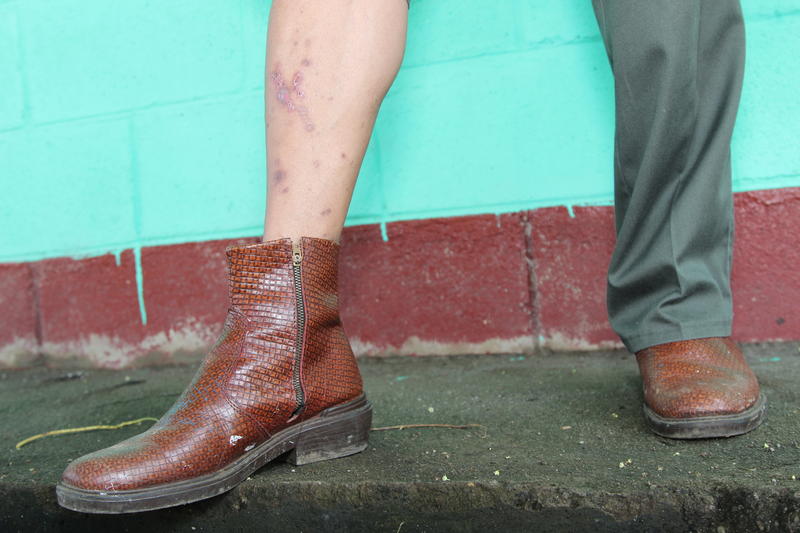
Las heridas de Silva Grijalva en su pierna derecha fueron producto de balas de goma disparadas por paramilitares a favor del gobierno, según Grijalva y otros que lo acompañaban.
Sin embargo, retomar el proceso negociador es difícil porque la oposición no está vertebrada, los líderes de los movimientos sociales no se atreven a comparecer, no hay partidos opositores efectivos, y tampoco hay libertad de reunión ni de expresión para debatir. En este sentido la interlocución es imperfecta y los únicos que se sientan en la mesa -la Alianza Cívica- no tiene fuerza social propia, si no que depende de actores internacionales y de la capacidad de movilización de la calle. La gran incógnita, hasta la fecha, es la posición del ejército, ya que si bien está muy vinculado a Ortega, también tiene fuertes intereses económicos, institucionales y de prestigio más allá de la permanencia del actual Presidente en el poder.
De todas formas, a la hora de escribir este texto (junio de 2019) no hay indicios de una pronta pacificación, a pesar de que hay signos de distensión—como la liberación de 56 presos el día 11 de junio. El discurso de Ortega se centra en denostar a los adversarios, en denunciar que ha sido víctima de un “golpe de estado blando” y en la llamada a sus fieles a la resistencia. En este sentido la consigna desde el poder es clara y contundente: “Daniel se queda”.
De todo ello sólo podemos afirmar que la crisis actual ha vuelto a mostrar algunas continuidades en el ejercicio y en la cultura política del poder en Nicaragua, a saber, la concentración de recursos en manos de un caudillo, el uso de la fuerza en momentos críticos y la incapacidad de las instituciones para resolver conflictos. Fruto de estas “continuidades” la violencia política y la impunidad han reaparecido en el país. Con todo, es difícil pensar que esta crisis pueda eternizarse. Cuesta imaginar que Ortega se mantenga ad infinitum en el poder sólo por la fuerza. En este sentido, el sacerdote, político y diplomático francés Charles Maurice de Tayllerdand ya advirtió hace un par de siglos que “Con las bayonetas, todo es posible. Menos sentarse encima”.
Spring/Summer 2019, Volume XVIII, Number 3
Salvador Martí i Puig, is a Professor of Political Science at the University of Girona (UdG) and a research associate at CIDOB-Barcelona. He has written on Latin American politics in general, particularly about Central America and Mexico. He has been an invited professor and researcher in universities in Latin America, Europe and the United States.
Salvador Martí i Puig, profesor de Ciencia Política de la Universidad de Girona (UdG) e investigador asociado del CIDOB-Barcelona. Ha investigado y escrito sobre política latinoamericana en general y, en especial, sobre Centroamérica y México. Ha sido profesor e investigador invitado en Universidades de América Latina, Europa y Estados Unidos.
Related Articles
Nicaragua: Editor’s Letter
Someone called out my name in the crowded lobby of Managua’s InterContinental Hotel. I screamed. There was Henry, the young Christian activist from Colombia who left to fight the dictatorship of Anastasio Somoza. Four different people had told me Henry, now known by his…
Botanical Studies in Nicaragua
The mountainous areas of northern Nicaragua finally felt safe enough to roam around after more than forty years of war. What we—two biologists—found was a treasure of unknown and rich plant diversity and beauty where the plants had not been seriously explored for decades…
Blood of Brothers Redux
Tension and long-suppressed anger mingled with shared pain when Nicaraguans who were bitter enemies in the civil war of the 1980s faced each other for the first time in the spring of 2019. Their encounter, at the Watson Institute for International and Public Affairs…

